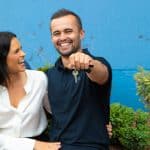Taking up space in STEM: One woman’s quest to change the face of tech
Celeste Carnegie and Larisha Jerome
- Career & Business, Womens

My name is Celeste Carnegie, and I’m a Birrigubba, Juru, South Sea Islander woman from North Queensland. My mob come from Ayr, which is part of the Burdekin region, about 45 minutes south of Townsville.
Larisha: Can you tell us a bit about some of the work that you do at the moment?
Celeste: I work for an organisation, a not-for-profit, called Indigitech. We work to increase the number of Aboriginal and Torres Strait Islander peoples in the technology sector in STEM-related careers. STEM is science, technology, engineering and maths. So, we do that through upskilling courses for helping our mob find employment; helping them on that path. We also look at just creating awareness around the different roles in the tech space, because that’s just something that we don’t have any awareness around.
We don’t even makeup one per cent of that of the technology sector.
So, it’s really about increasing the awareness and getting our communities to it to a place where they’re where they can make their own informed decisions about what they want to do with technology.
Larisha: That’s so deadly. And what about your role advocating for women in the tech space, especially as a blak woman within this space?
Celeste: I guess that’s just a part of the everyday for me. I’m very passionate about helping our women achieve their goals through technology and with technology. I wish I could focus purely, or primarily, on women, but we’re just we’re just not there yet in this in this sector.
Larisha: What do you think needs a change in this sector for women?
Celeste: It’s a heavily white space… The issue is, is that it’s those same males that are making the decisions and making decisions on innovation, making decisions on who’s allowed to be a part of said innovation and gatekeeping – gatekeeping when they don’t really have access to the lived experience of others. And that’s what’s missing. It’s a diversity and lived experience in that industry.
Larisha: What does digital inclusion mean for First Nations people, do you think?
Celeste: I think that means something different to everybody. I think that’s the beauty of technology and digital technologies. I think that we all have the ability to customise what that looks like for ourselves. I think that for me now, personally, digital inclusion means access and the education around how to use technology and how to use it in a way that benefits oneself.
Our young people today are moving through and they don’t know a world without it. So, it’s like, “How do I how can I help them? How can I support them to use technology to benefit themselves and to maybe create a future for themselves in whatever way that that looks like for them?”
I think that digital technology for me and digital inclusion also means the luxury of having options and the freedom of choice.
This is an edited transcript of Rich Blak Women, a podcast that shares inspiring stories from First Nations women. To hear more, visit https://tomorrowmoney.co/women/rbw/
Let us know if you liked this article
Let us know if you liked this article




